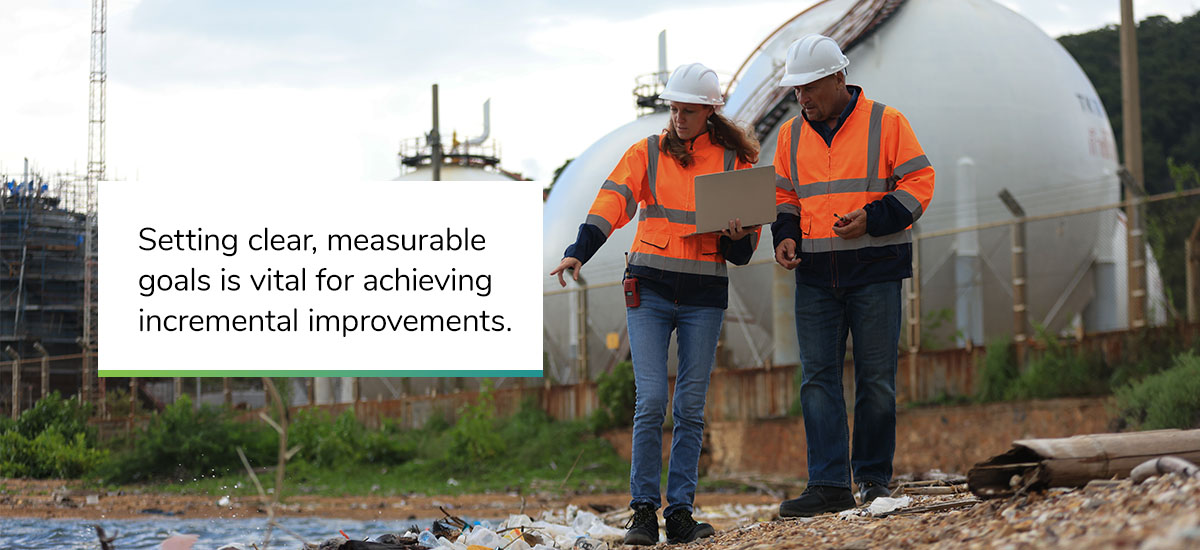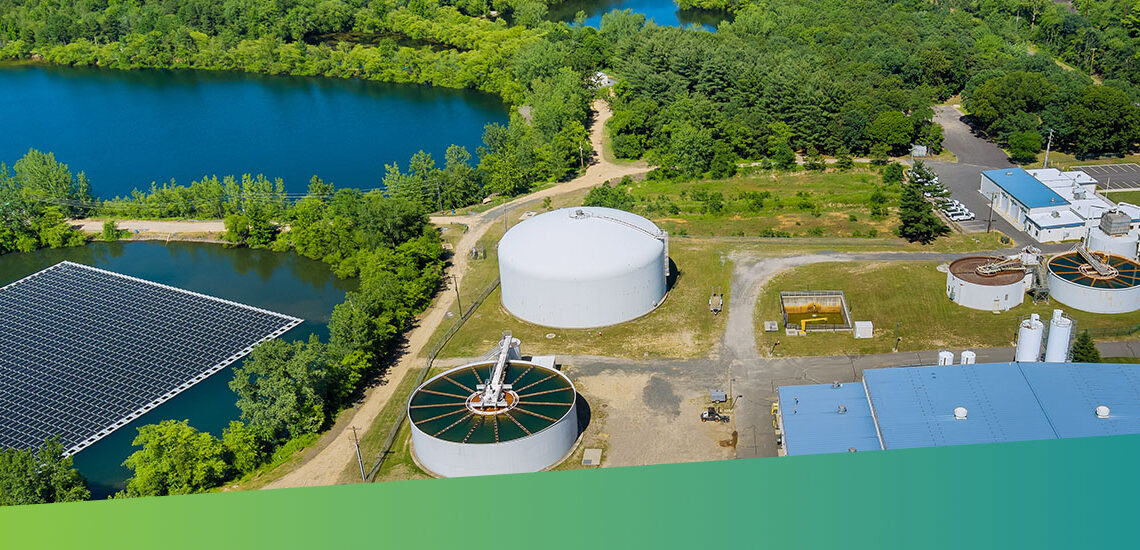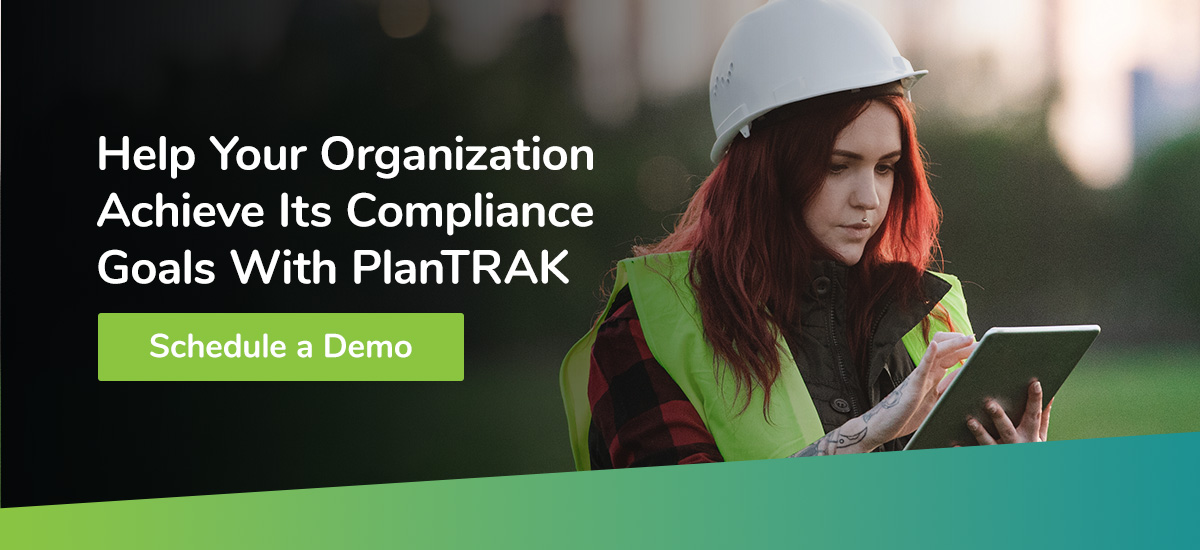Continuous Improvement in Environmental Compliance
Maintaining environmental compliance is not just about avoiding fines or meeting regulations — it’s about fostering operational excellence. Whether you’re minimizing waste, improving energy efficiency, or streamlining compliance processes, every action contributes to your organization’s overall sustainability and risk management. For manufacturing, agricultural, and food production facilities, staying compliant requires more than just meeting the status quo. It demands continuous improvement.
Adopting a mindset of continuous improvement empowers organizations to reduce noncompliance risks, adapt to evolving regulations, and build resilience against operational disruptions. If you’re an environmental director or manager looking for actionable steps for maintaining environmental compliance, use this guide to implement some best practices and improvements.
Best Practices in Environmental Compliance
Environmental compliance has many moving parts. Focusing on these fundamental practices will help you identify potential risks and foster continuous improvement.
1. Understand Environmental Compliance
The foundation of compliance lies in understanding the specific regulations governing your industry. Federal and state requirements such as the following dictate how your facility must operate:
- Clean Water Act: The Clean Water Act is a federal law that regulates water pollution by making it unlawful for any waste or pollutants to be discharged into navigable waters.
- Clean Air Act: The Environmental Protection Agency (EPA) aims to reduce air pollutants with the Clean Air Act. This federal law holds organizations responsible for protecting the nation’s air quality and the stratospheric ozone layer.
- SPCC: The Spill Prevention, Control, and Countermeasure (SPCC) rule prevents oil from reaching navigable waters and shorelines.
- NPDES: The National Pollutant Discharge Elimination System (NPDES) prevents water pollution by regulating discharge pollutants from stormwater and wastewater.
- RCRA/SARA reporting: The Resource Conservation and Recovery Act (RCRA) and Superfund Amendments and Reauthorization Act of 1986 Title III (SARA), also known as the Emergency Planning and Community Right-to-Know Act, are reporting requirements for organizations. Businesses must submit reports to publicly disclose the use, storage, and disposal of hazardous chemicals.
- ISO 14001: ISO 14001 is the international standard for environmental policy and requirements. Organizations can receive training to obtain ISO 14001 certification, showing their dedication to reducing their environmental impact and ensuring regulatory compliance.
Conduct a gap assessment on your current processes to evaluate your alignment with these standards and any others that apply. This step will help you determine what goals you should set to begin working toward improved compliance.
2. Establish a Strong Foundation
Once you understand your organization’s environmental compliance obligations, it’s time to identify gaps and areas for improvement. You can do this by conducting a comprehensive internal environmental audit. Once you have the results of how your facility is performing, you can make adjustments to address compliance issues such as:
- Inadequate spill prevention controls: Audits frequently find that organizations lack properly maintained spill kits, secondary containment for hazardous materials, and spill response plans.
- Lack of stormwater management controls: Poorly maintained stormwater controls, such as sediment traps or oil-water separators, represent a common compliance issue. Proper documentation for these controls is also frequently missing, compounding the problem.
- Lack of training records: Failure to create and maintain complete documentation for employee training on spill response, hazardous waste handling, and environmental management practices can lead to violations.
- Poor housekeeping in waste storage areas: Overflowing waste containers, spills, or lack of general cleanliness in areas where you store hazardous materials is a serious compliance risk.
To proactively eliminate these issues and facilitate continuous improvement, train your employees on these concerns and encourage them to report any anomalies they discover.
Managers can use PlanTRAK’s Audit Tool to record audit findings and assign corrective actions to specific employees. This tool provides accountability and visibility into the steps your organization is taking to improve your compliance.
Routine inspection checklists, such as our SPCC inspection checklist and our stormwater inspection checklist, help you stay proactive by highlighting common issues in your facility. A tool like PlanTRAK can take you a step further by automatically assigning these checklists and triggering follow-up actions for any deficiencies. These capabilities ensure nothing slips through the cracks and keep your team focused on consistent compliance.
3. Implement Continuous Improvement Strategies
Continuous improvement is a powerful business philosophy that encourages all members of an organization to identify and suggest new ways to improve operations. In terms of environmental compliance, it involves using a closed feedback loop to continually:
- Research and plan ways to improve existing products or processes.
- Unofficially launch the new plans.
- Test and monitor the changes in normal operations and provide feedback.
- Make needed adjustments and roll out the new changes.
This process enables you to make small changes over time that will eventually lead you to achieving your environmental compliance goals.

Setting clear, measurable goals is vital for achieving incremental improvements. The following examples provide an excellent starting point:
- Cut greenhouse gas (GHG) emissions by 20% within five years by transitioning to renewable energy sources or upgrading fleet vehicles to electric models.
- Reduce hazardous waste generation by 25% within the next 12 months through improved waste segregation and recycling initiatives.
- Lower energy consumption by 15% over two years by optimizing equipment use and upgrading to energy-efficient systems.
- Reduce stormwater-related violations to zero over the next 18 months by implementing proactive inspection schedules and maintaining stormwater controls.
- Achieve ISO 14001 certification within two years by developing and implementing a tailored Environmental Management System.
Providing ongoing training sessions on compliance responsibilities for employees is another key strategy for continuous improvement. It’s critical to educate staff on current environmental policy, objectives, targets, emergency procedures, and awareness because it teaches them what to watch for in your everyday operations and empowers them to make suggestions for further changes.
Directors, managers, and other organizational leaders can engage more directly in continuous improvement by:
- Holding regular meetings: Meeting with other leaders at regular intervals can help company executives determine whether monthly performance targets have been achieved. They can also collaborate to establish countermeasures if improvements are needed.
- Implementing a methodology: Business process methodologies like Agile place emphasis on the cyclical nature of iterative continuous improvement, which can help guide your organization in consistently recognizing and implementing opportunities for further improvement.
- Utilizing the right tools: Advanced solutions like PlanTRAK make it easier for users at various levels of your organization to assign tasks and monitor progress on key initiatives, which is essential for improving visibility and accountability.
PlanTRAK simplifies this process by integrating tools for task management, progress tracking, and real-time reporting, ensuring your improvement strategies stay on course.
4. Engage Stakeholders
Involving your stakeholders in your environmental, social, and governance (ESG) strategies can contribute to your environmental compliance goals. Stakeholder engagement is critical for continuous improvement toward these goals because it can help your organization meet increasingly strict regulatory requirements and build strong relationships.
It’s important to ensure transparency, communication, and inclusive participation so that all stakeholders who are affected by your organization’s operations have a say in how environmental compliance is handled. With an environmental compliance management system, you can more effectively align your business goals with regulatory requirements. Additionally, your environmental compliance management system acts as a centralized platform for key individuals to collaborate, stay informed, and maintain transparent reporting processes.
5. Leverage PlanTRAK for Environmental Compliance Management
If you’re looking for a way to streamline compliance monitoring processes, an environmental compliance management system may be right for you. PlanTRAK is your trusted compliance management software solution built to help you meet your unique industry requirements. PlanTRAK can support continuous improvement in environmental compliance with the following features and capabilities:
- Workflow automation to ensure timely compliance actions
- Simplified document management and recordkeeping
- Reduced administrative burden
- Identify obligations across departments or facilities
- Centralized compliance requirements
- Access to extensive reports
- Data analytics and trends
- User-friendly controls
- Continuous support for seamless adoption and usage
- Comprehensive training programs
- Reduced labor costs
- Streamlined management review and follow-ups
Help Your Organization Achieve Its Compliance Goals With PlanTRAK
Continuous improvement requires regularly assessing your existing processes to identify gaps and compliance risks. Implementing a few best practices and the right resources can help you stay ahead of constant environmental regulation changes. With PlanTRAK, you can simplify environmental compliance by seeing exactly what’s going on in your facility.
Organize, assign, and track compliance tasks across your organization to prevent violations and penalties. Using PlanTRAK, you can also improve documentation, recordkeeping, and delegation to strive for continuous improvement. Request a demo of PlanTRAK today to see how our software can help you achieve your compliance goals!

